Plasma levels of lysophosphatidic acid in ovarian cancer versus controls: a meta-analysis
- PMID: 26174150
- PMCID: PMC4501043
- DOI: 10.1186/s12944-015-0071-9
Plasma levels of lysophosphatidic acid in ovarian cancer versus controls: a meta-analysis
Abstract
Background: In this study, using a meta-analysis approach, we examined the correlation between serum levels of lysophosphastidic acid (LPA) and ovarian cancer (OC).
Methods: Relevant published studies were identified from multiple scientific literature databases by using a pre-determined electronic and manual search strategy. The search results were screened through a multi-step process to select high-quality case-control studies suitable for the present meta-analysis. Mean values and standardized mean differences (SMD) were calculated for plasma LPA levels. Two investigators independently extracted the data from the studies and performed data analysis using STATA software version 12.0 (Stata Corp, College Station, TX, USA).
Results: Nineteen case-control studies met our selection criteria and contained a total of 980 OC patients, 872 benign controls and 668 healthy controls. Our meta-analysis results revealed that the plasma levels of LPA in OC patients were significantly higher than benign controls (SMD = 2.36, 95% CI: 1.61-3.10, P < 0.001) and healthy controls (SMD = 2.32, 95% CI: 1.77-2.87, P < 0.001). Subgroup analysis by ethnicity showed that the plasma LPA levels in OC patients were significantly higher than the benign controls only in Asian populations (SMD = 2.52, 95% CI: 1.79-3.25, P < 0.001). However, a comparison between healthy controls and OC patients revealed that, in both Asians and Caucasians, the OC patients displayed significantly higher plasma LPA levels compared to healthy controls (all P < 0.05).
Conclusion: Our meta-analysis showed strong evidence that a significantly higher plasma LPA levels are present in OC patients, compared to benign controls and healthy controls, and plasma LPA levels may be used as a biomarker or target of OC.
Figures
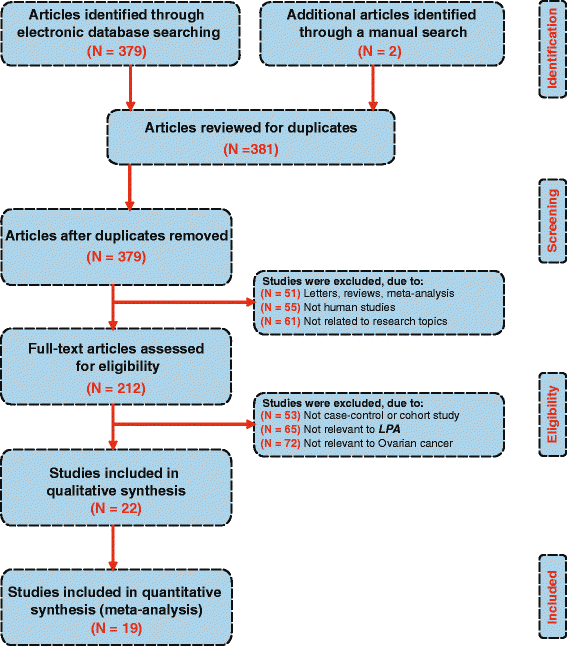
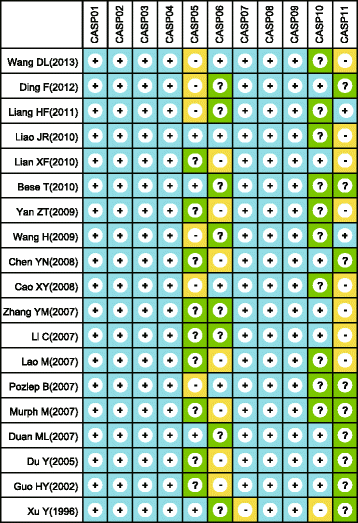
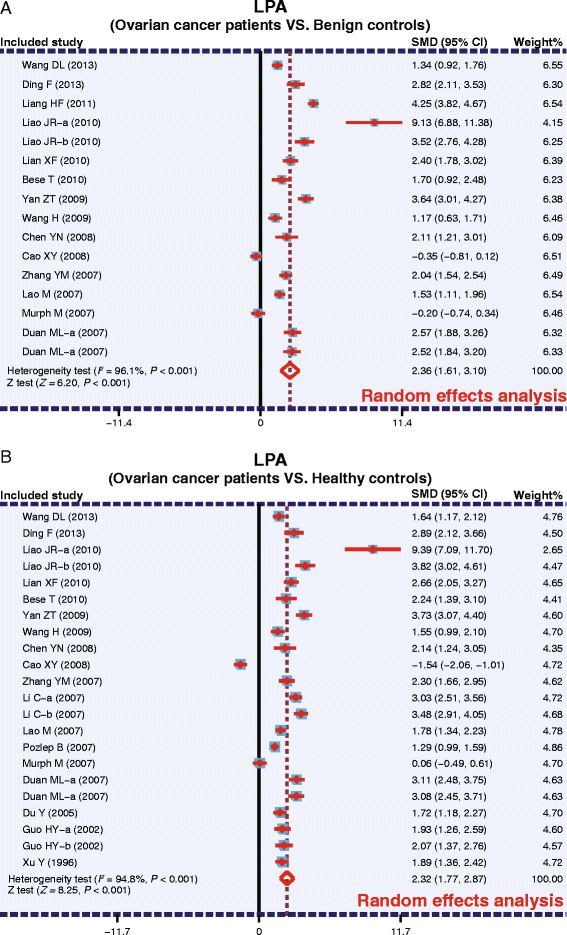
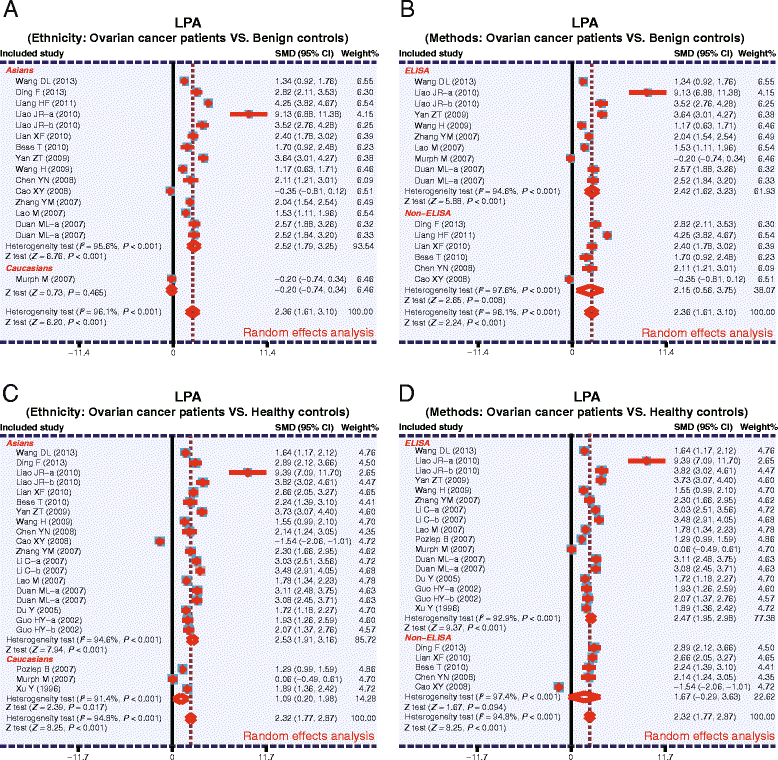
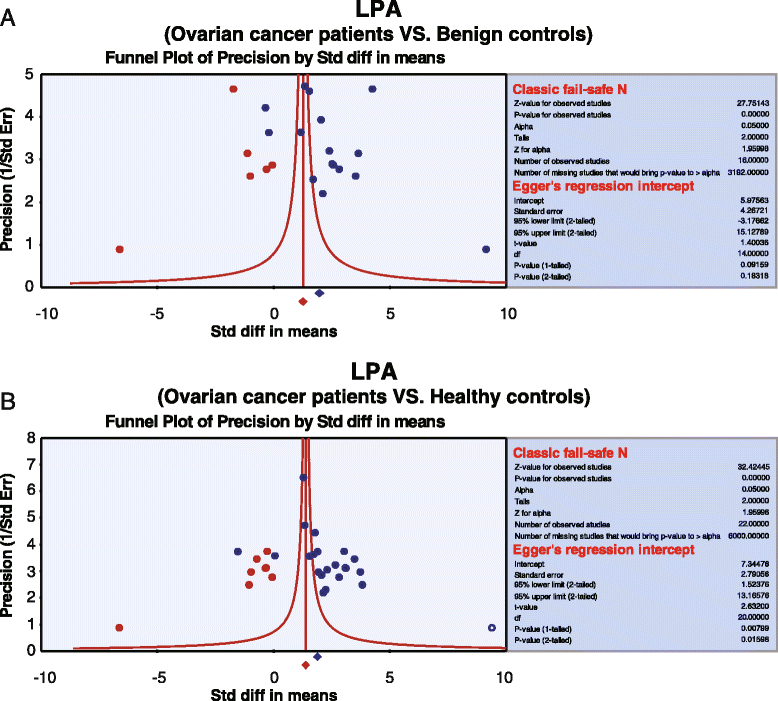
Similar articles
-
Diagnostic value of plasma lysophosphatidic acid levels in ovarian cancer patients: A case-control study and updated meta-analysis.J Obstet Gynaecol Res. 2015 Dec;41(12):1951-8. doi: 10.1111/jog.12806. Epub 2015 Oct 16. J Obstet Gynaecol Res. 2015. PMID: 26472266
-
Clinical significance of plasma lysophosphatidic acid levels in the differential diagnosis of ovarian cancer.J Cancer Res Ther. 2015 Apr-Jun;11(2):375-80. doi: 10.4103/0973-1482.157335. J Cancer Res Ther. 2015. PMID: 26148603
-
Lysophosphatidic acid as a potential biomarker for ovarian and other gynecologic cancers.JAMA. 1998 Aug 26;280(8):719-23. doi: 10.1001/jama.280.8.719. JAMA. 1998. PMID: 9728644
-
Interleukin-17 SNPs and serum levels increase ulcerative colitis risk: a meta-analysis.World J Gastroenterol. 2014 Nov 14;20(42):15899-909. doi: 10.3748/wjg.v20.i42.15899. World J Gastroenterol. 2014. PMID: 25400476 Free PMC article. Review.
-
Association between C-reactive protein level and subsequent risk of ovarian cancer: A meta-analysis of 13 cohorts in 1,852 ovarian cancer patients.Medicine (Baltimore). 2020 Jan;99(5):e18821. doi: 10.1097/MD.0000000000018821. Medicine (Baltimore). 2020. PMID: 32000385 Free PMC article.
Cited by
-
Facile Titrimetric Assay of Lysophosphatidic Acid in Human Serum and Plasma for Ovarian Cancer Detection.J Cancer Prev. 2023 Jun 30;28(2):31-39. doi: 10.15430/JCP.2023.28.2.31. J Cancer Prev. 2023. PMID: 37434795 Free PMC article.
-
Interrelations of Sphingolipid and Lysophosphatidate Signaling with Immune System in Ovarian Cancer.Comput Struct Biotechnol J. 2019 Apr 10;17:537-560. doi: 10.1016/j.csbj.2019.04.004. eCollection 2019. Comput Struct Biotechnol J. 2019. PMID: 31049165 Free PMC article.
-
Sex Differences in Plasma Lysophosphatidic Acid Species in Patients with Alcohol and Cocaine Use Disorders.Brain Sci. 2022 Apr 30;12(5):588. doi: 10.3390/brainsci12050588. Brain Sci. 2022. PMID: 35624975 Free PMC article.
-
The "Janus Face" of Platelets in Cancer.Int J Mol Sci. 2020 Jan 25;21(3):788. doi: 10.3390/ijms21030788. Int J Mol Sci. 2020. PMID: 31991775 Free PMC article. Review.
-
Systematic review and meta-analysis of studies assessing the relationship between statin use and risk of ovarian cancer.Cancer Causes Control. 2020 Oct;31(10):869-879. doi: 10.1007/s10552-020-01327-8. Epub 2020 Jul 20. Cancer Causes Control. 2020. PMID: 32685996 Free PMC article.
References
Publication types
MeSH terms
Substances
LinkOut - more resources
Full Text Sources
Other Literature Sources
Medical
Miscellaneous

